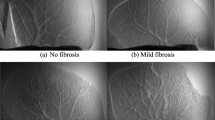Abstract
In order to improve the accuracy of cirrhosis staging diagnosis based on MR images, a diagnostic method combining image texture feature extraction and classification algorithm is proposed. Firstly, the liver MR image is preprocessed, the region of interest (ROI) image patch is extracted therefrom, and the ROI image is quantized and compressed by the Lloyd algorithm. Then, the ROI image is filtered by a local binary pattern (LBP) operator, and then the texture feature of a 20-dimensional gray-level co-occurrence Matrix (GLCM) in four directions on the LBP image is extracted. Finally, MR image is classified by performing support vector machine (SVM) and the final diagnosis of liver cirrhosis is obtained. The experimental results show that the proposed method can accurately diagnose liver cirrhosis.





Similar content being viewed by others
References
Damayanti, A., and Werdiningsih, I., Classification of tumor based on magnetic resonance (MR) brain images using wavelet energy feature and neuro-fuzzy model[C]. Journal of Physics Conference Series:012027, 2018.
Lee, J., Jung, J. H., Kim, W. W. et al., The role of preoperative breast magnetic resonance (MR) imaging for surgical decision in patients with triple-negative breast cancer[J]. Journal of Surgical Oncology 113(1):12–16, 2016.
Lo, G. C., Besa, C., King, M. J. et al., Feasibility and reproducibility of liver surface nodularity quantification for the assessment of liver cirrhosis using CT and MRI.[J]. Eur J Radiol Open:95–100, 2017.
Ahmed, S., Iftekharuddin, K. M., and Vossough, A., Efficacy of Texture, Shape, and Intensity Feature Fusion for Posterior-Fossa Tumor Segmentation in MRI[J]. IEEE Transactions on Information Technology 15(2):2058–2068, 2011.
Sompong, C., and Wongthanavasu, S., MRI brain tumor segmentation using GLCM cellular automata-based texture feature[C]. Computer Science & Engineering Conference:3021–3032, 2014.
Sarwinda, D., Bustamam, A., and Ardaneswari, G., Non-negative matrix factorization in texture feature for classification of dementia with MRI data[C]. International Symposium on Current Progress in Mathematics & Sciences:1205–1209, 2017.
Khalvati, F., Modhafar, A., Cameron, A. et al., A Multi-Parametric Diffusion Magnetic Resonance Imaging Texture Feature Model for Prostate Cancer Analysis[C]. International Conference on Medical Image Computing & Computer Assisted Intervention:692–698, 2014.
Chaddad, A., Zinn, P. O., and Colen, R. R., Radiomics texture feature extraction for characterizing GBM phenotypes using GLCM[C]. IEEE International Symposium on Biomedical Imaging:3695–3702, 2015.
Guo, Y. J., Sun, Z. J., Sun, H. X. et al., Texture feature extraction of steel strip surface defect based on gray level co-occurrence matrix[C]. International Conference on Machine Learning & Cybernetics:69–78, 2015.
Liu, L. Y., and Fan, X. J., The Design of System to Texture Feature Analysis Based on Gray Level Co-Occurrence Matrix[J]. Applied Mechanics & Materials:904–907, 2015.
Jiang, Y., Zhao, K., Xia, K., Xue, J., Zhou, L., and Yang, D., Pengjiang Qian:A Novel Distributed Multitask Fuzzy Clustering Algorithm for Automatic MR Brain Image Segmentation. J. Medical Systems 43(5):118–129, 2019.
Liu, Q., Liu, X. P., Zhang, L. J. et al., Image Texture Feature Extraction & Recognition of Chinese Herbal Medicine Based on Gray Level Co-Occurrence Matrix[J]. Advanced Materials Research 60(5):2240–2244, 2013.
Li, P., Xiong, Y., Xie, F. et al., Trabecular texture analysis in dental CBCT by multi-ROI multi-feature fusion[C]. IEEE International Symposium on Biomedical Imaging:25–32, 2014.
Borodkin, S. M., Borodkin, A. M., and Muchnik, I. B., Optimal requantization of deep grayscale images and Lloyd-Max quantization[J]. IEEE Transactions on Image Processing 15(2):445–448, 2006.
Yang, S., Meng, F., Jiang, X. H. et al., An improved image quality objective assessment method using non-linear calibration algorithm[C]. The 2014 7th International Congress on Image and Signal Processing:591–595, 2014.
Tang, Z., Wang, S., Huo, J. et al., Bayesian Framework with Non-local and Low-rank Constraint for Image Reconstruction[C]. Journal of Physics Conference Series:123–128, 2017.
Ojala, T., Pietikäinen, M. et al., Multiresolution Gray-Scale and Rotation Invariant Texture Classification with Local Binary Patterns[M]. Computer Vision – ECCV 2000. Berlin/Heidelberg: Springer, 2000, 404–420.
Xia, K., Gu, X., and Zhang, Y., Oriented grouping-constrained spectral clustering for medical imaging segmentation. Multimedia Systems 6, 2019. https://doi.org/10.1007/s00530-019-00626-8.
Gang, Z., Li, X., Zhou, L. et al., Development of a Gray-Level Co-Occurrence Matrix-Based Texture Orientation Estimation Method and Its Application in Sea Surface Wind Direction Retrieval From SAR Imagery[J]. IEEE Transactions on Geoscience & Remote Sensing 29(9):1–17, 2018.
Youssef, D., El-Ghandoor, H., Kandel, H. et al., Estimation of Articular Cartilage Surface Roughness Using Gray-Level Co-Occurrence Matrix of Laser Speckle Image[J]. Materials 10(7):714–719, 2017.
Xia, K., Yin, H., Qian, P., Jiang, Y., and Wang, S., Liver Semantic Segmentation Algorithm Based on Improved Deep Adversarial Networks in Combination of Weighted Loss Function on Abdominal CT Images. IEEE Access 7:96349–96358, 2019.
Xia, K., Yin, H., and Zhang, Y.-D., Deep Semantic Segmentation of Kidney and Space-Occupying Lesion Area Based on SCNN and ResNet Models Combined with SIFT-Flow Algorithm. J. Medical Systems 43(1):2:1–2:12, 2019.
Qian, P., Jiang, Y., Wang, S., Su, K.-H., Wang, J., Hu, L., and Muzic, Jr., R. F., Affinity and penalty jointly constrained spectral clustering with all-compatibility, flexibility, and robustness. IEEE Transactions on Neural Networks and Learning Systems 28(5):1123–1138, 2017.
Qian, P., Zhao, K., Jiang, Y., Su, K.-H., Deng, Z., Wang, S., and Muzic, Jr., R. F., Knowledge-leveraged transfer fuzzy c-means for texture image segmentation with self-adaptive cluster prototype matching. Knowledge-Based Systems 130:33–50, 2017.
Author information
Authors and Affiliations
Corresponding author
Ethics declarations
We declare that we have no conflict of interest. The paper does not contain any studies with human participants or animals performed by any of the authors. Informed consent was obtained from all individual participants included in the study.
Additional information
Publisher’s Note
Springer Nature remains neutral with regard to jurisdictional claims in published maps and institutional affiliations.
This article is part of the Topical Collection on Transactional Processing Systems
Rights and permissions
About this article
Cite this article
chunmei, X., mei, H., yan, Z. et al. Diagnostic Method of Liver Cirrhosis Based on MR Image Texture Feature Extraction and Classification Algorithm. J Med Syst 44, 11 (2020). https://doi.org/10.1007/s10916-019-1508-x
Received:
Accepted:
Published:
DOI: https://doi.org/10.1007/s10916-019-1508-x




